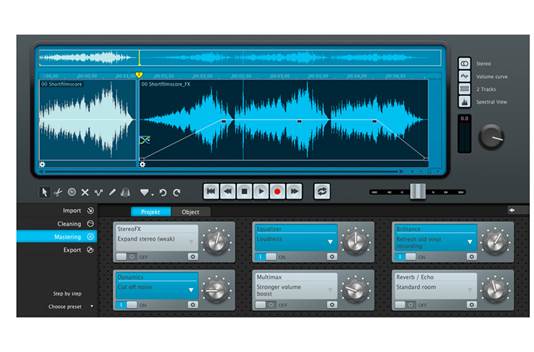Magix isn’t a well-known name in the Mac
market, but its Audio Cleaner software has been very popular with PC users who
need to digitize old vinyl records and cassettes. As well as recording audio,
the program includes a variety of filters and other tools you can use to clean
up the sound on those old recordings, as well as adjusting specific frequencies
to improve the overall sound quality.
This new Mac version of Audio Cleaner Pro
is a fairly faithful adaptation of the PC version, and so might look a bit
daunting to Mac users who are used to the simplicity of iTunes or GarageBand.
The program’s main Project Window displays a variety of tools and controls that
may seem unfamiliar unless you already have experience of audio editing
software. However, the key to using Audio Cleaner Pro is the set of four simple
buttons tucked down into the lower left-hand corner of the window.

Scratch
that: Audio Cleaner Pro includes a number of preset filters for removing
scratches and other noises
These buttons represent the four stages of
the audio cleaning process: Import, Cleaning, Mastering and Export. By default,
Audio Cleaner Pro launches in Import mode, which provides three simple options.
If you have suitable recording equipment, you can use the program to record
straight from your old records and tapes. The current release can only record
as MP3, WAV, AIFF or OGG Vorbix, but Magix is working on a patch that will
enable you to convert files and export them as AAC files at the final Export
stage.
You can also rip music from CD or import
existing audio files, so we quickly imported the MP3 file of an old 12in vinyl
single of Chain Reaction by Diana Ross to see if AudioCleaner Pro could remove
some of the worst hissing and crackling noises. Once you’ve created or imported
your audio file, the waveform for the file is displayed in the upper half of
the Project Window, and you can then hit the Cleaning button to start work.
Cleaning mode includes five filters that
can be used to remove the most obvious flaws in your recordings. These all have
self-explanatory names, such as the DeHisser and DeCrackler. However, focusing
on specific parts of a recording was more difficult. The main problem is that
the PDF manual and help files aren’t really helpful. Even simple tasks such as
zooming in on a loud crackle right at the start of Chain Reaction took us a
while, as the manual seems to list tools and features in a fairly random order.

For
the record: You can record directly from vinyl if you have suitable recording
equipment connected to your Mac
If you persevere, though, you’ll find that
Audio Cleaner Pro can produce good results. After wading through the manual for
a while, we did manage to remove a number of loud crackles and scratches from
Chain Reaction, and use the DeHisser to make the overall sound of the recording
a bit clearer.
You can then move on to the program’s
Mastering tools, which are designed to fine-tune specific aspects of the
recording. Again, some of the options here are self-explanatory – ‘emphasize
voice’ and ‘max bass’ are straightforward enough but if you don’t know what
‘invert left phase’ means, you’ll have to go scurrying off to the manual again.
Thankfully, the Export stage is nice and easy.

Audio
Cleaner Pro software
Audio Cleaner Pro does work well, and is a
worthwhile investment if you’ve got a stack of old records that you’d like to
digitize and use in iTunes. However, Magix need to make this more of a Mac app
if it’s to compete with rivals such as the excellent Sound Studio.
|
Specifications
·
Audio Cleaner Pro
·
Cleaner software for digitizing records
·
From: App Store
·
Info: magix.com
·
Needs: OS X 10.6.6
·
Pro: Inexpensive – lightweight and Mac-like –
Supports plug-ins – Powerful batch processor
·
Con: Interface could be cleaner – You can’t
record lots of individual tracks
·
Price: $53
·
Verdict: 3/5
|